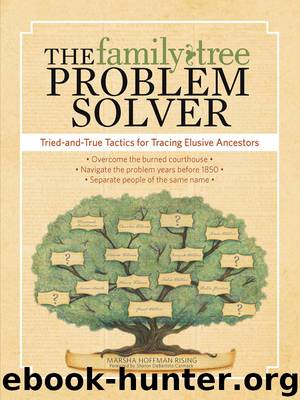The Family Tree Problem Solver: Tried and True Tactics for Tracing Elusive Ancestors by Rising Marsha Hoffman & Rising Marsha Hoffman

Author:Rising, Marsha Hoffman & Rising, Marsha Hoffman [Rising, Marsha Hoffman]
Language: eng
Format: epub
Publisher: F+W Media
Published: 2011-03-23T04:00:00+00:00
This marriage is recorded neither in Missouri nor Tennessee.
In the genealogy The Sims Brown Family [of South Carolina], James Alvan Brown writes, “Richard S. Brown m. (2) Elizabeth Parham. Richard d. 16 March 1841. Nothing is further known about Elizabeth Parham Brown. A supposition is that she remarried and moved west.” South Carolina did not begin to record marriages until 1911, but a deed dated 24 May 1852 recorded in Newberry County, South Carolina, Deed Book EE:117-118, states that: “Eliza Tranum of Macon County, Alabama, sold land which had belonged to the estate of her husband R.S. Brown, deceased, and that she had since intermarried with Joseph Tranum, who has also died.” Thus we have record of the residence of Richard Brown's widow and her subsequent marriage.
A deed may also contain a record of a marriage contract. One such contract was recorded 16 October 1812, in Newberry Deed Book N:209 between Charles Thompson of Newberry District, South Carolina, and Nancy Gray, widow, of Abbeville District, South Carolina, stipulating certain financial conditions.
Always check cemetery records and tombstones, where you can find “wife of” and sometimes “daughter of.” Marriage records can be difficult to locate in New York. The state censuses of 1865 and 1875 give the dates of marriage for a couple from the preceding year.
If county land records have been destroyed, don't neglect the federal land entries for those states defined as “federal land states” rather than “state land states.” All of the land records I have obtained for Pulaski and Taney counties in Missouri have come from the federal records. Yet, I know exactly what parcel each early settler owned. Microfilmed copies of all federal land states (except Missouri and Alaska) are available at the Family History Library. Once you have an approximate land description for the parcel of your interest, the tract books will provide you with the number of the case entry file, which may include additional information. Also see Patricia Law Hatcher's Locating Your Roots: Discover Your Ancestors Using Land Records (Cincinnati: Betterway Books, 2003), pages 79–95. Although some counties have lost all public records to fire, in most cases, at least a few remain. It is important to examine all extant records to glean any available clue.
Download
This site does not store any files on its server. We only index and link to content provided by other sites. Please contact the content providers to delete copyright contents if any and email us, we'll remove relevant links or contents immediately.
Twilight of the Idols With the Antichrist and Ecce Homo by Friedrich Nietzsche(17724)
CHERUB: The Recruit by Robert Muchamore(1844)
CHERUB: The Fall by Robert Muchamore(1716)
CHERUB: Man vs Beast by Robert Muchamore(1617)
I Capture the Castle by Dodie Smith(1580)
The Edge of the Abyss (Sequel to The Abyss Surrounds Us)(1472)
Black Genesis by Robert Bauval(1325)
A Brief History of Everyone Who Ever Lived by Adam Rutherford(1255)
all by Unknown Author(1246)
Where Do I Start? by Chase Taylor Hackett(1062)
2016 Baby Names Almanac(982)
Painfully Rich by John Pearson(959)
Genetics by Adam Rutherford(928)
How to Argue With a Racist by Adam Rutherford(884)
2011 Baby Names Almanac(847)
Black Hawk Down by Mark Bowden(833)
It's All Relative by A. J. Jacobs(801)
Spook Street (Slough House) by Mick Herron(791)
My European Family by Karin Bojs(787)
